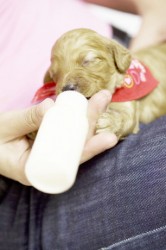Over the last two weeks we have been discussing the formula which we could use as a substitute for the dam’s milk. Today we will explain how best we can ensure that the formula gets into the puppy’s stomach.
How to give the formula
Puppies may be fed by spoon or eyedropper, baby nursing bottle, or stomach tube.
An eyedropper is readily available and may be used as an emergency measure in the absence of a baby nursing bottle or stomach tube. However, one has to be extremely careful because puppies can choke when formula is dropped or spooned into their mouths. This can lead to aspiration into the lungs. The baby bottle has the advantage of satisfying the suckling urge but requires that the puppy to be strong enough to suck the formula.

The best way to feed a puppy is to place him on his stomach, open his mouth with the tip of your finger, insert the nipple and hold the bottle at 45 degrees. The angle of the bottle is such that air does not get into the puppy’s stomach. Keep a slight pull on the bottle to encourage vigorous sucking. A bottle-fed puppy will need to be burped.
Tube feeding has several advantages. It takes about two minutes to complete each feeding. No air is swallowed (no burping is required). It ensures that a proper amount of formula is administered to each puppy. It is the only satisfactory method of feeding immature or sick puppies too weak to nurse.
If too much formula is fed, or if given too rapidly, it can be regurgitated (vomited up). This can lead to aspiration of formula into the lungs and consequently to pneumonia. The complication can be avoided, if care is taken to monitor the weight of the puppy and calculate the correct amount. Puppies fed by tube should be kept in separate compartments.
Tube feeding is not difficult and can be mastered in a few minutes. It requires a soft rubber catheter (soft flexible tube) – size 8 to 10 (French), this tube can be bought at any good drugstore. A 10 or 20 cc plastic or glass syringe is also necessary. You may wish to purchase a gram scale to calculate the weight of each puppy and to monitor his progress.

At about 14 days of age the windpipe of many puppies will be large enough to accommodate the tube. If the tube goes down the wrong way the puppy will begin to cough and choke. Change to a larger tube; or by now the puppy may be strong enough to suckle from a bottle.
Happy Diwali. Please do not throw squibs/fire crackers at or near to dogs or cats.
Please implement disease preventative measures (vaccinations, routine dewormings, monthly anti-Heartworm medication, etc) and adopt-a-pet from the GSPCA’s Animal Clinic and Shelter at Robb Street and Orange Walk, if you have the wherewithal to care well for the animals. Do not stray your unwanted pets, take them to the GSPCA’s Clinic and Shelter instead. If you do not wish your pet to have puppies or kittens, you may exploit the GSPCA’s free spay and neutering programme. If you see anyone being cruel to an animal, or if you need any technical information, please get in touch with the Clinic and Shelter by calling 226-4237.





